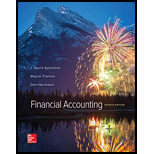
Financial Accounting
4th Edition
ISBN: 9781259307959
Author: J. David Spiceland, Wayne M Thomas, Don Herrmann
Publisher: McGraw-Hill Education
expand_more
expand_more
format_list_bulleted
Question
Chapter D, Problem 17RQ
To determine
Investment:
It refers to the process of using the currently held excess cash to earn profitable returns in future. The investments can be made in equity securities such as shares or debt securities such as bonds.
To identify: the effect on the carrying value of the investment in bonds and the amount recorded for interest revenue over time, in case the bonds are purchased at discount.
Expert Solution & Answer
Want to see the full answer?
Check out a sample textbook solution
Students have asked these similar questions
Subject: Financial Accounting A manufacturing company failed to make a year-end accrual of $280,000 for environmental penalties. Its tax rate is 35%. As a result of this error, net income was: (a) Unaffected (b) Overstated by $182,000 (c) Overstated by $98,000 (d) Overstated by $280,000
Matrix Solutions reported net income of $350,000.
Need answer
Chapter D Solutions
Financial Accounting
Ch. D - Prob. 1RQCh. D - 2.How can an investor benefit from an equity...Ch. D - 3.How might investing activity for a company that...Ch. D - Provide an example of an equity investment in...Ch. D - Prob. 5RQCh. D - Prob. 6RQCh. D - Prob. 7RQCh. D - Prob. 8RQCh. D - Prob. 9RQCh. D - 10.When using the fair value method, we adjust the...
Ch. D - Prob. 11RQCh. D - 12.Under what circumstances do we use the equity...Ch. D - Prob. 13RQCh. D - Prob. 14RQCh. D - Prob. 15RQCh. D - 16.What is the flip side of an investment in debt...Ch. D - Prob. 17RQCh. D - Prob. 18RQCh. D - Prob. 19RQCh. D - Prob. 20RQCh. D - Prob. D.1BECh. D - Prob. D.2BECh. D - Prob. D.3BECh. D - Prob. D.4BECh. D - Prob. D.5BECh. D - Prob. D.6BECh. D - Prob. D.7BECh. D - Prob. D.8BECh. D - Prob. D.9BECh. D - Prob. D.10BECh. D - Prob. D.11BECh. D - Prob. D.12BECh. D - Prob. D.1ECh. D - Prob. D.2ECh. D - Prob. D.3ECh. D - Prob. D.4ECh. D - Prob. D.5ECh. D - Prob. D.6ECh. D - Prob. D.7ECh. D - Prob. D.8ECh. D - Prob. D.9ECh. D - Prob. D.10ECh. D - Prob. D.11ECh. D - Prob. D.1APCh. D - Prob. D.2APCh. D - Prob. D.3APCh. D - Prob. D.4APCh. D - Prob. D.1BPCh. D - Prob. D.2BPCh. D - Prob. D.3BPCh. D - Prob. D.4BP
Knowledge Booster
Similar questions
- Please provide the correct answer to this general accounting problem using valid calculations.arrow_forwardPlease show me the correct approach to solving this financial accounting question with proper techniques.arrow_forwardFinancial Accounting: At an output level of 45,000 units, you calculate that the degree of operating leverage is 2.30. If output rises to 61,650 units, what will the percentage change in operating cash flow be?arrow_forward
arrow_back_ios
SEE MORE QUESTIONS
arrow_forward_ios
Recommended textbooks for you
- Principles of Accounting Volume 1AccountingISBN:9781947172685Author:OpenStaxPublisher:OpenStax College
 College Accounting, Chapters 1-27AccountingISBN:9781337794756Author:HEINTZ, James A.Publisher:Cengage Learning,
College Accounting, Chapters 1-27AccountingISBN:9781337794756Author:HEINTZ, James A.Publisher:Cengage Learning, Intermediate Accounting: Reporting And AnalysisAccountingISBN:9781337788281Author:James M. Wahlen, Jefferson P. Jones, Donald PagachPublisher:Cengage Learning
Intermediate Accounting: Reporting And AnalysisAccountingISBN:9781337788281Author:James M. Wahlen, Jefferson P. Jones, Donald PagachPublisher:Cengage Learning

Principles of Accounting Volume 1
Accounting
ISBN:9781947172685
Author:OpenStax
Publisher:OpenStax College

College Accounting, Chapters 1-27
Accounting
ISBN:9781337794756
Author:HEINTZ, James A.
Publisher:Cengage Learning,

Intermediate Accounting: Reporting And Analysis
Accounting
ISBN:9781337788281
Author:James M. Wahlen, Jefferson P. Jones, Donald Pagach
Publisher:Cengage Learning